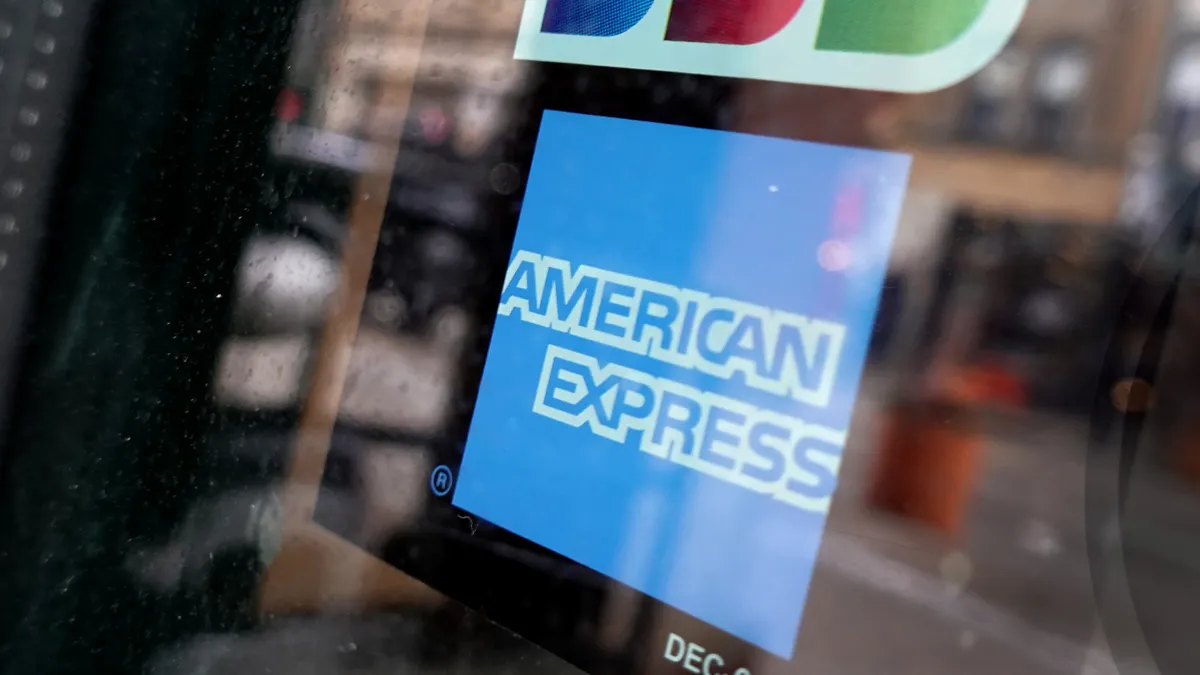As card companies, banks and fintechs compete for customers, and the lines between their financial services become blurrier, American Express is pushing further into banks' territory and targeting younger consumers.
The card network became a bank holding company in 2008 amid the Great Recession, and introduced such options as high-yield savings accounts. Now, it's making more use of that designation, launching debit cards for small business and consumers alike in recent months, as well as all-digital checking account services.
Digital checking has gone mainstream amid the COVID-19 pandemic and card members have said they want more from AmEx, so "it really just seemed like the right time for us to make a move here," said the company's vice president of consumer banking, Liz Bergman, who oversees digital checking and debit product management.
To further entrench relationships with current credit cardholders and meet demand from younger spenders, AmEx in February launched all-digital consumer checking account services tied to a debit card loyalty program. The company's executives aim to attract debit card users with the account's perks.
AmEx CFO Jeff Campbell said he doesn’t see card rivals Visa and Mastercard as the company’s competitors. Rather, banks like JPMorgan Chase and Barclays, and small fintechs are the company's new challengers, he said last month at the Keefe, Bruyette & Woods Fintech and Payments Conference.
The checking account offer is a natural brand extension for American Express, said James Angel, a finance professor at Georgetown University.
"The more relationships you have with a customer, the stickier the relationship becomes," he said in an interview.
There’s no shortage of competitors in the digital banking space, as neobanks and other digital-first outlets have gained steam in recent years.
AmEx has examined a number of players, from fintechs to traditional brick-and-mortar banks, and is trying to incorporate the best of the bunch, Bergman said in an interview.
Powered by record amounts of capital, fintechs have set the standard when it comes to digital experiences on mobile and web. Because Gen Z and millennial consumers have high expectations, AmEx aims to match those digital experiences while adding the kinds of features its cardholders have come to expect, Bergman said.
Last week, AmEx grappled with digital issues when some customers encountered website and mobile app outages.
Brand matters, too, Bergman said. And in that regard, AmEx is positioning itself as an established player with a far lengthier track record than newer entrants. Considering those factors and the rewards offering for debit, "we don’t see one competitor playing in all those spaces," Bergman said.
Fellow card network Discover announced last week it had revamped its checking offering, which isn’t limited to credit cardholders, and added early access to paychecks as an account benefit. Unlike Discover and AmEx, Visa and Mastercard don't hold bank licenses and aren't in the business of offering such services directly to consumers.
As both the network and issuer, AmEx is exempt from a regulation that caps debit fees and earns full or market-rate interchange on debit transactions, which is partly why the company can offer an account that’s "chock full" of benefits, said Sarah Grotta, director of Mercator Advisory Group's debit and alternative products group. The checking service features an annual percentage yield of 0.5%, rewards on debit purchases, purchase protection and no monthly maintenance fees or account minimums.
"They have an opportunity to be a formidable presence in the marketplace" — especially if the user experience is on par with or better than other digital account offerings, Grotta said.
Capturing a broader clientele
AmEx’s checking product is an example of the company’s shift from providing credit services to fairly wealthy individuals to serving a broader audience, Grotta said.
Amex launched a debit card for small businesses in October. At the company’s March 16 investor day, CEO Steve Squeri touted those debit products as examples of AmEx tapping its network to extend services. "You don’t need brick-and-mortar to have deposits," Squeri said.
Since the checking account is only available to existing cardholders, AmEx is being deliberate with its strategy. It’s mainly a way to capture existing customers’ spending and give younger consumers what they’re looking for, Mihir Bhatia, a global research analyst at Bank of America, said in an interview.
"It’s certainly attractive and increases optionality overall for AmEx, but in the near term, it’s a little bit more incremental than truly changing the nature of AmEx’s business," Bhatia said.
AmEx will evaluate in the coming months whether to open up the checking offering more broadly, Bergman said.
Skirting surcharges with checking
One big hurdle AmEx must overcome to gain market share is apathy.
"Most people, when you ask them if they’re going to change where they have their checking account, they’re going to say 'no,'" Grotta said.
But as the COVID-19 pandemic solidified debit’s hold on the marketplace — there were more debit card transactions than credit card transactions for the first time in history — a consumer checking offering was a tempting opportunity.
"I’m sure American Express doesn’t want to lose out on all that transactional activity," Grotta said.
Indeed, AmEx Vice Chairman Doug Buckminster indicated the company sees the checking account offering as a way to rope in Gen Zers and millennials who might prefer debit. And if faced with surcharges for credit transactions, "we want our customers to have an American Express alternative when they make the choice to avoid that surcharge," Buckminster said during the company's investor day last month.
Younger consumers have led much of the growth in debit over the past year, and Bergman said she believes the rewards and protections AmEx offers "will naturally attract customers" who are heavy debit users.
During the company’s most recent earnings call in January, Squeri said millennials and Gen Zers represented about 60% of new accounts acquired globally in 2021. Younger cardholders are particularly enticing to AmEx because the company's high retention rate among customers means those youngsters are valuable lifetime prospects, Campbell said on the call. He didn't specify what that retention rate is.
Bergman wouldn’t share the number of cardholders who’ve opened checking accounts, or any future targets. She said the company's penetration goals are "aggressive," and AmEx members tend to have multiple relationships across the company’s products.
"There’s certainly a lot of ripe opportunity with our existing base," Bergman said.












